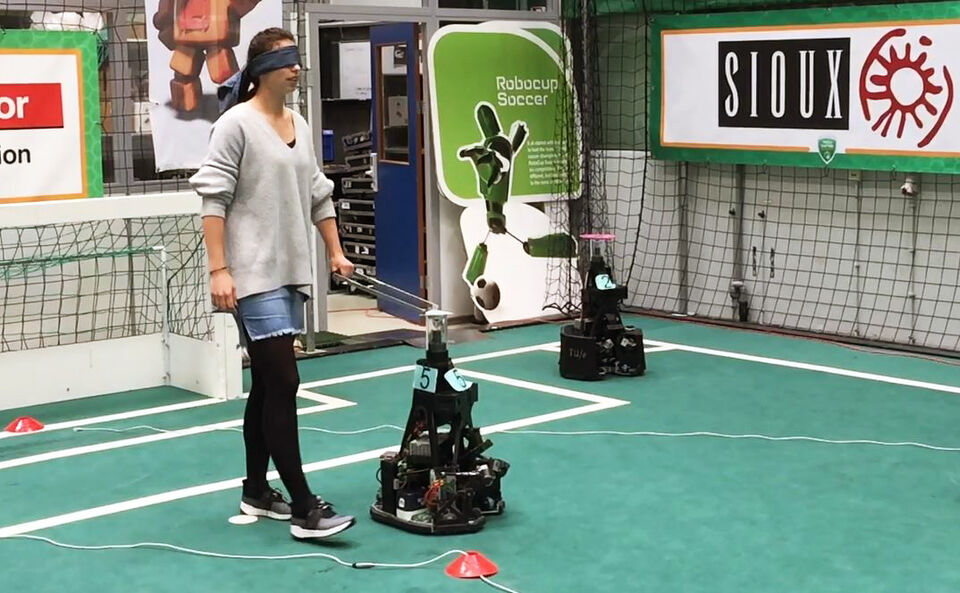Football robot turns into guide dog for the blind
The football robots of Tech United can do more than just kick a ball. This was recently proved by a group of bachelor’s students together with graduating student of Mechanical Engineering Jerrel Unkel: they adapted a ‘TURTLE’ of Tech United in such a way that it could be used as a guide dog for the blind. For the time being only on the football pitch in the Gemini building, but who knows what the future will bring.
Training guide dogs for the blind is an intensive and costly procedure. That explains why there is a big shortage of these dogs, says third-year student of Software Science Thomas Wiepking. This gave him and his team mates Jarno Brils, Dylan ter Veen, Renée van Hijfte and Anne Kolmans the idea to examine for their assignment for the USE course Robots Everywhere whether a robot could take over the tasks of a seeing-eye dog.
Article continues below video
While looking for a robot that might be suitable for this, the bachelor’s students came across graduating student Jerrel Unkel at Tech United. This mechanical engineer was just involved in trying to teach one of the football robots to cope with counter pressure and frictional resistance. “The idea is that you want to make robots in hospitals help move beds or trolleys through the corridors”, Unkel explains. “In the end they have to be able to do so fully autonomously, but it’s already very helpful if they can be used like a kind of smart auxiliary motor. This requires that they need to understand that they must assist when the nurse gives the bed a shove, for instance.”
Football pitch
Unkel’s project fitted in perfectly with what the bachelor’s students wanted, says Wiepking. “This way of controlling can also be used to make the robot give counter pressure when it approaches the curb too much, for instance.” The students put it to the test on the football pitch of Tech United in the Gemini building and let one of them be guided by the robot while blindfolded (see the film). “We delineated a track with white lines and used a ball as an obstacle, because the robot recognizes a ball very well. The robot gives proportional counter pressure, depending on how close it comes to the line and how fast it is moving. This makes the guidance feel very natural.”
In the end it turned out to be simpler to program the track in the robot’s memory, says Wiepking. “So the robot knew where the lines were located, and did not need to use its cameras for that; we laid out the lines especially for ourselves, really, by way of reference.” The students did program whether the ‘blind person’ was left- or right-handed. “Then the robot took this into account for calculating the distance it had to keep away from the curb.”
If the human subject walked neatly in the center of the sidewalk, he did not feel any resistance: the system designed by Unkel was set in such a way that the frictional resistance with the floor was compensated exactly, for a programed ‘resistance factor’ of ‘0’. “At a resistance factor of ‘1’ the robot braked at full power”, Wiepking explains.
Build on
Of course, the football robot is far from being a fully-fledged replacement of a seeing-eye dog, but according to Wiepking the concept of the USE course is that following generations of students can build on from their work. “For that purpose we have had to document everything meticulously.” Who knows? Maybe the project will result in a fully-fledged guide robot for the blind one day.


Discussion